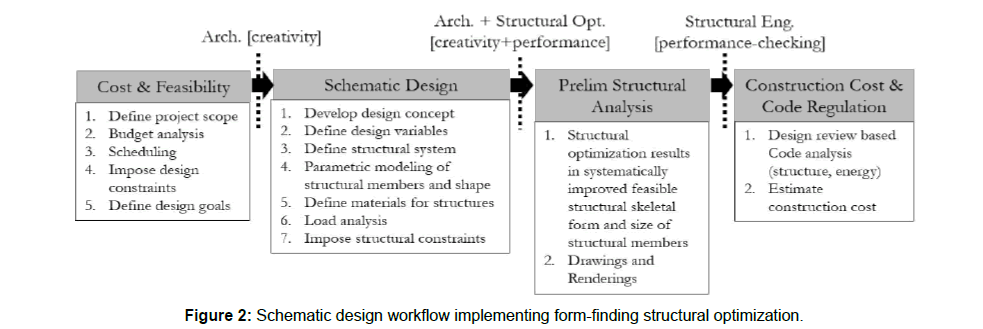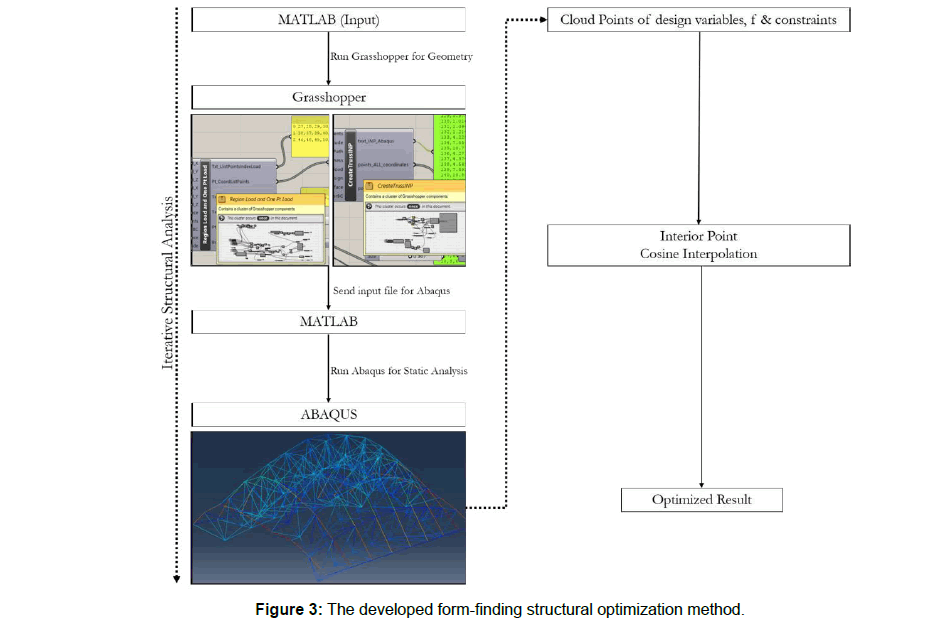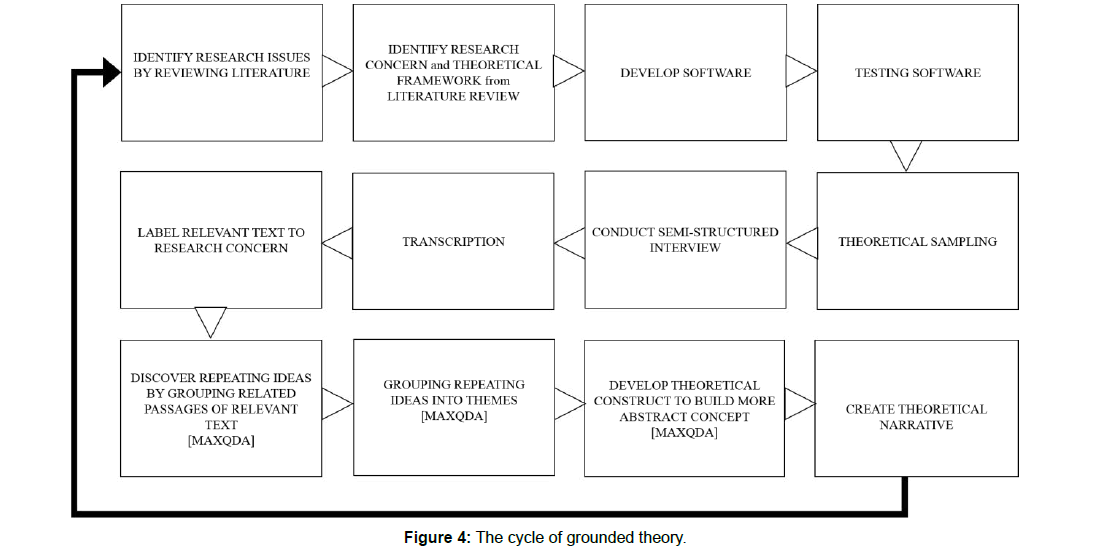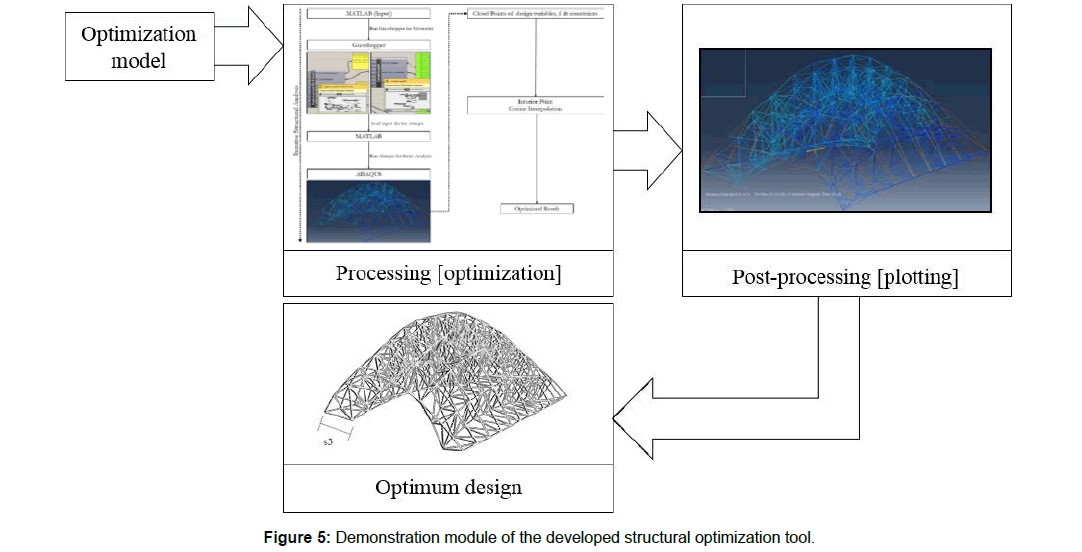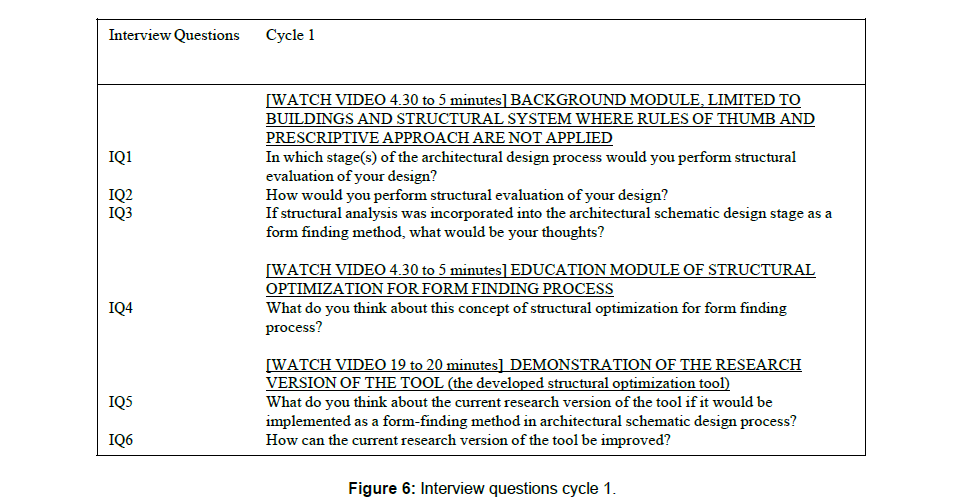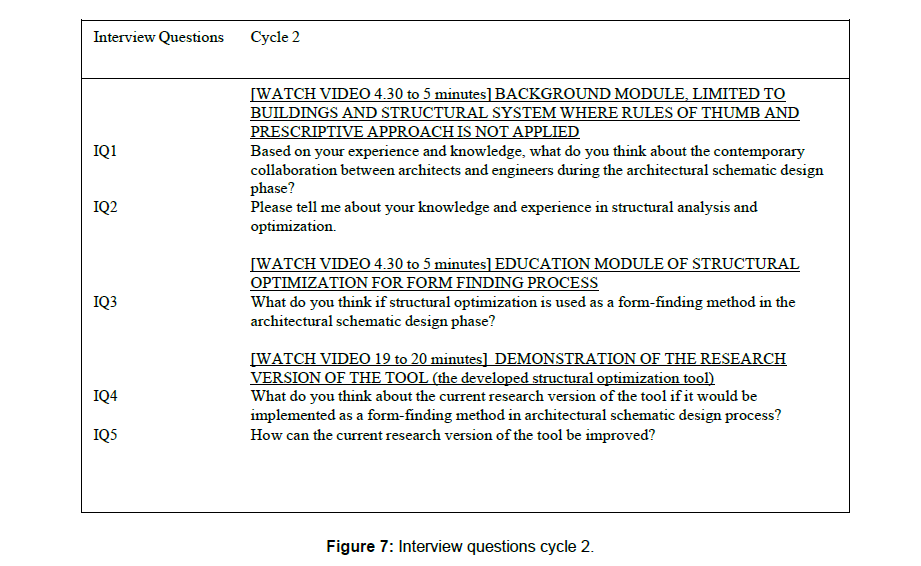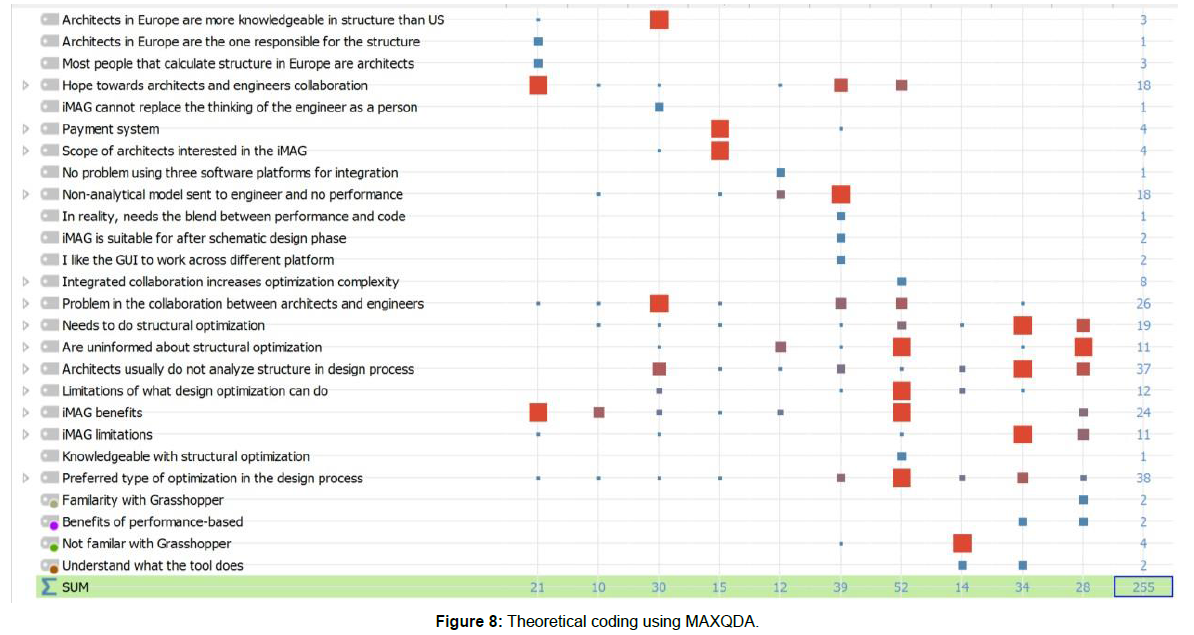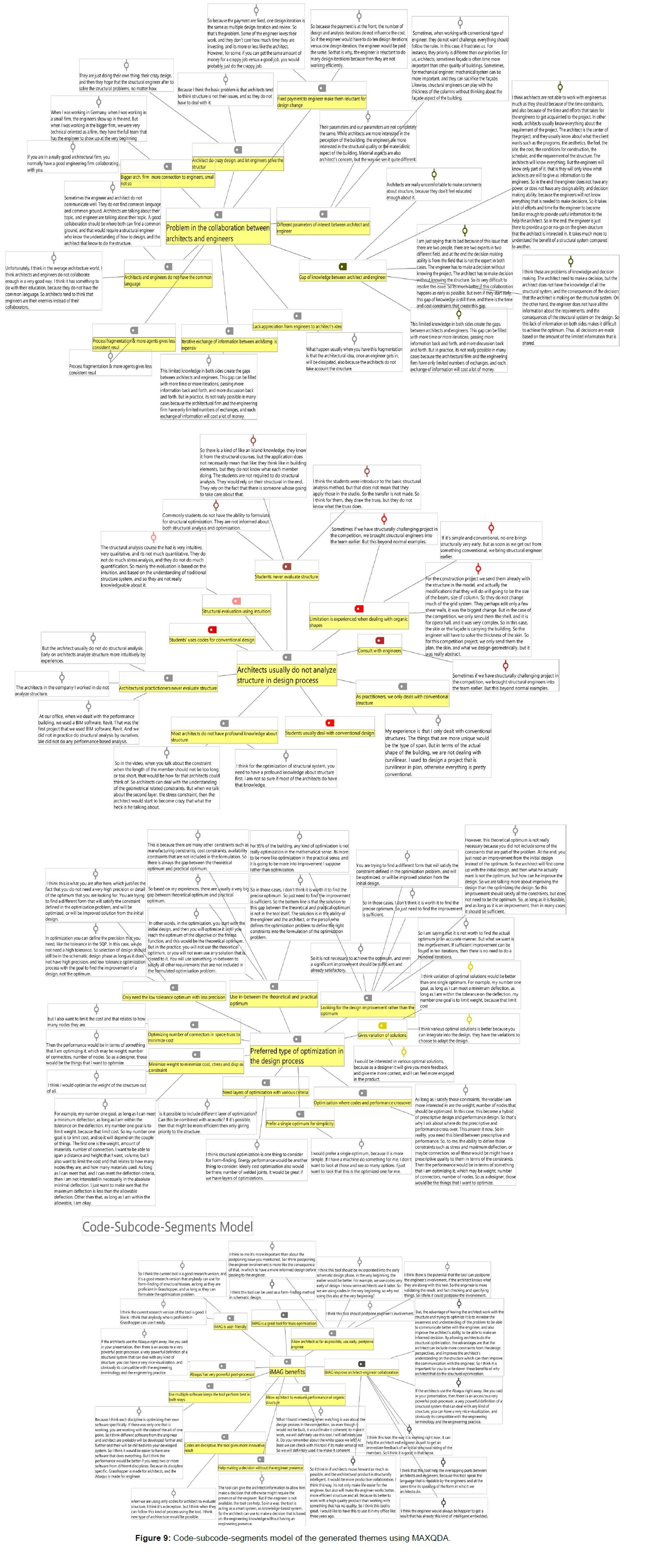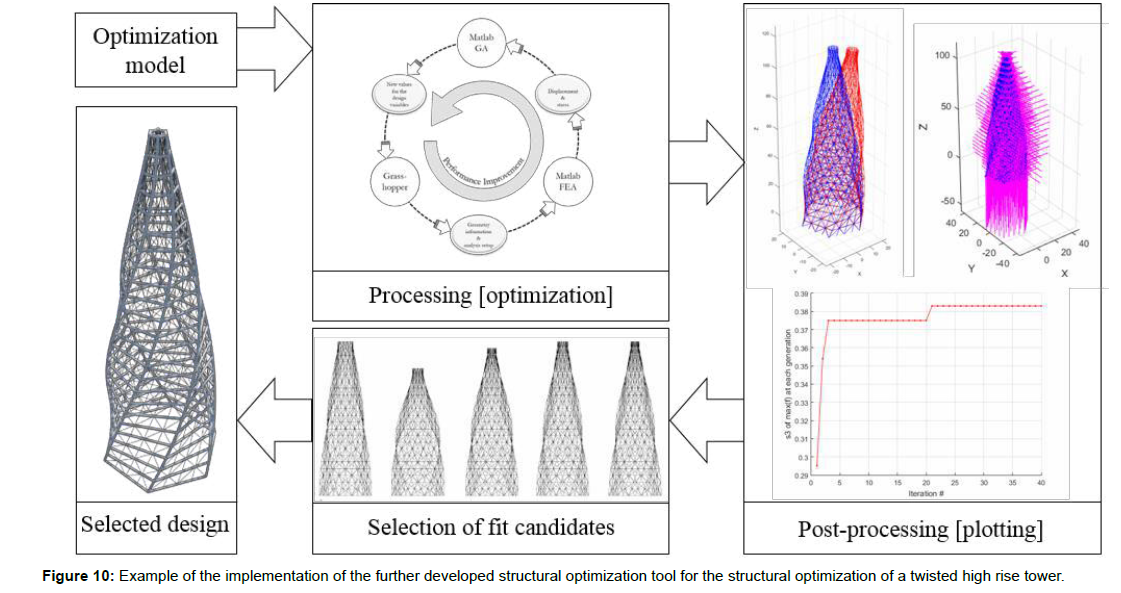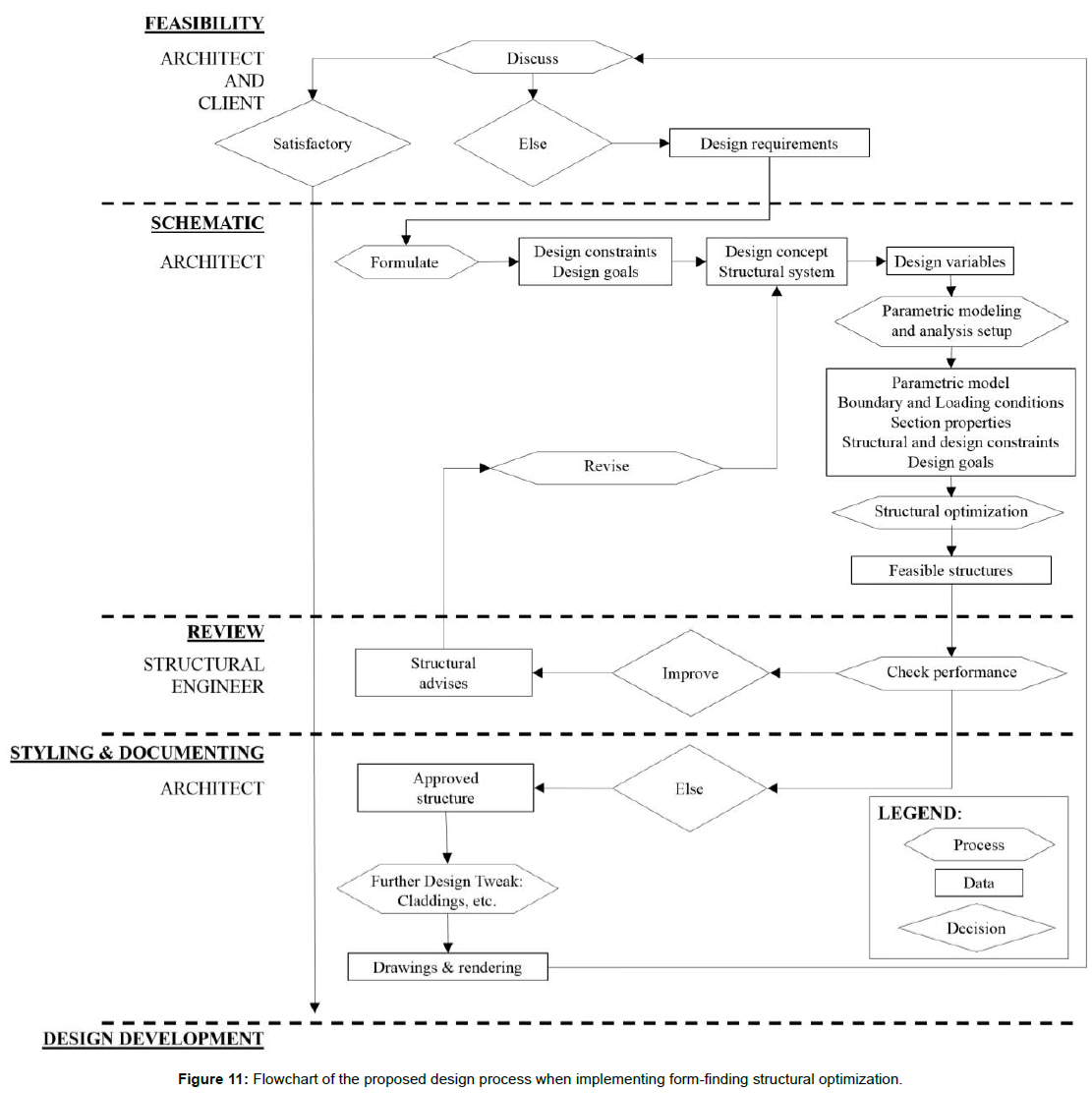Using Grounded Theory for the Development of a Structural Optimization Tool as a Form-Finding Method for Architectural Schematic Design
Received: 30-Mar-2018 / Accepted Date: 01-May-2018 / Published Date: 08-May-2018 DOI: 10.4172/2168-9717.1000217
Abstract
This paper presents a qualitative examination of the responses of architects towards the idea for including a formfinding structural optimization method in the architectural schematic design phase. Recently, there has been a few emerging architectural parametric Computer-Aided Design (CAD) systems that enable architects to perform an early schematic form-finding structural optimization such as the coupling of Grasshopper (a visual programming language), Karamba (structural analysis plugin) and Galapagos (optimization plugin). However, the architectural schematic design phase is commonly characterized by free-form shapes without the embedded considerations of the material and structural system. On the other hand, the considerations of materiality and structural system are often more properly imposed by the structural engineers, who usually prefer to be involved as early as possible in the project. Seen from this perspective, this paper discusses the examination process and findings related to the difficulties in the traditional design workflow that separate the architectural form generation process from the engineering aspect of structural performance; the interoperability and integration of architectural parametric CAD tools, engineering analysis and optimization tools as well as the usability of these tools; and the implementation of structural optimization in the architectural schematic design phase. This paper discusses the process of the investigation of these concerns qualitatively using Grounded Theory for data collection and analysis, and for the software development and testing process. Clemson University students and faculty were sampled as research participants. Form-finding structural optimization software that couples Grasshopper, Matlab (a scientific programming language) and Abaqus (finite element analysis software) was developed as a design method to facilitate the interviewing process. The software MAXQDA is used for the qualitative data analysis.
Keywords: Collaboration; Schematic design; Structural optimization; Form-finding; Grounded theory
Introduction
Many research studies have highlighted the problems of the current collaboration between architects and structural engineers. Although the forms of the research statements and findings vary, many converge towards the following opinion: structural engineers and architects often speak different ‘languages’, i.e., one as a technician who lacks innovation and another as an artist whose primary focus is merely on appearance, and the differences often lead to frustration on both sides during the collaboration process [1-6]. A considerable amount of researchers agree that inefficient and ineffective communication is often the culprit of a project failure [7-9]. The communication failure between engineers and architects often occurs during the transition from the schematic to the design development phase. Particularly, the structural constraints that are introduced to the conceptual design by engineers often do not meet the design intent imagined by the architects. Architects often formulate design goals and constraints on the client’s demands, site context, architectural programs, budget and time before the development of the design concept in the schematic design phase. On the other hand, structural constraints are formulated by structural engineers with respect to the structural system, materiality and load analysis after the schematic design phase. Figure 1 shows the contemporary design workflow.
In the context of computer systems, the contemporary transition from the conceptual to the design development phase is commonly identical to the switch from the Computer Aided Design (CAD) based system to the Building Information Modeling (BIM) tool. Per Gentry’s definition, CAD system is characterized by its amaterial or material agnostic approach (e.g. Rhinoceros, Maya) [10]. Whereas BIM is considered by many as a more restraining modeling process in which a model is represented by objects, and is constrained by the characteristics of architectural elements (wall, beam, columns, etc.) and the embedded consideration of materiality (e.g. Revit, Digital Project) (for details about BIM, [11]. In the contemporary design process, the preliminary structural analysis of the schematic form is performed by the engineers, and the design development (detail drawings including mechanical, electrical and plumbing through BIM implementation) is after the estimation of construction cost and code regulation. Notwithstanding the popularity of this workflow, recently, there have been few burgeoning attempts to challenge the traditional design process through the implementation of form-finding structural optimization in the architectural design process. As opposed to the contemporary design process, the recently developed plugins such as Karamba and Galapagos in Grasshopper allows the schematic form to be generated based on the structural system, structural constraints and the consideration of materiality. Grasshopper is a visual programming language that runs within Rhinoceros CAD software (the amaterial system), a free-form surface modeling tool that is highly suitable for developing schematic forms. Figure 2 illustrates the design workflow that implements the form-finding structural optimization.
Despite the emergence of those tools, there is not much research that qualitatively investigates the broader impact of the form-finding structural optimization implementation towards the architectengineers collaboration. Based on this issue, three research concerns are developed as follows:
1. Examine difficulties in the traditional design workflow that separate the architectural form generation process from the engineering aspect of structural performance.
2. Study the interoperability and integration of architectural parametric CAD tools and engineering analysis and optimization tools as well as the usability of these tools.
3. Examine the implementation of structural optimization in the architectural schematic design phase.
These research concerns are qualitatively examined using Grounded Theory for data collection and analysis process. The term Grounded Theory was originated by Glaser and Strauss [12] as “the discovery of theory from data that is systematically obtained and analyzed.” Due to the lack of publications and studies on these concerns, the only viable research method for examining these issues is the qualitative approach. It is important to note that a qualitative research method such as Grounded Theory does not assume that the researcher knows enough to formulate specific hypotheses [13]. Thus, unlike in traditional quantitative research methods, research questions are not formulated. Instead, research concerns are used to drive the research process. The reason for using a qualitative research method as opposed to a quantitative research method is the fact that architects generally do not have sufficient knowledge of statics and structural mechanics to be able to sufficiently understand the process involved in structural optimization. Thus, it is assumed in this research that it is necessary to have back and forth communication between participants (architects) and the researcher during the data collection process.
The communication is necessary to educate the participants about architectural, structural optimization such that the responses from the participants are the mix of the newly acquired education and their academic and design practice experiences.
The target population for the qualitative study is the Clemson University architectural students and faculty. The second section of this paper briefly discussed form-finding structural optimization software that was developed during the study to facilitate the interviewing process and as an example method that can be used for implementing formfinding structural optimization in the design process. The third section discusses the Grounded Theory procedure and how it is applied in this study for data collection and analysis to gain in-depth understanding towards the issues being raised above and for the software development purpose. The fourth section discusses the findings that are written as theoretical narrative reflecting the research participants’ responses toward the issues being raised and the developed tools. The fifth section presents how the outcomes of the research help develop the tool. Finally, the sixth section of this paper discusses the proposed design flowchart for implementing form-finding structural optimization method in the design process.
Form finding architectural, structural optimization tool
The developed optimization tool integrates Grasshopper (a visual programming language in Rhino), Abaqus (a finite element software) and Matlab (a scientific programming language). This tool is initially used for the interview. The responses from the interviews are then used to modify the software further. Premade components in Grasshopper were made to allow parametric control over the structural analysis setup (loading conditions, element type, and section properties) and to manage the interoperability between Grasshopper and Abaqus. Matlab manages the interaction between Grasshopper and Abaqus to initially perform a full factorial analysis which is followed by interpolation and a deterministic optimization procedure. The workflow is shown in Figure 3.
A user interface is made to streamline the process, and to make the Matlab programming scripts invisible to the user.
Grounded theory
The Grounded Theory methodology is commonly applied in the social sciences to construct a theory. The methodology uses research participants’ subjective experiences as a source of knowledge [13]. Grounded Theory methodology has also been considered appropriate for many architectural research projects that are interested in the study of social phenomena as they relate to the designed environment [14]. Examples of applying Grounded Theory into an architectural research were presented by Bollo and Collins (2017) for studying occupancy in affordable housing and occupancy on plug load energy use in student residence halls. Not many research studies in architecture have included the tedious process of software development, especially software that incorporate the complexity of engineering analysis into the field of architectural design. If there were, the developed software have never been systematically tested in terms of usability to architectural practioners. Thus, the few existing architectural-engineering design and analysis software are only widespread among academia, but not among practioners. This research is perhaps the first that attempts to implement architectural, social-science research method, i.e. Grounded Theory, to develop architectural-engineering structural optimization software. The Grounded Theory feature, namely the cycle of theoretical sampling, semi-structured interviews, and coding, is considered aligned with the research purpose that is to examine the social phenomena related to the collaboration between architects and structural engineers, to educate architects about structural optimization and the utilization of the developed optimization software, and to use the feedback for the cyclic process of the software development.
This study considers that the interview responses to the corresponding research concerns raised above cannot be objectively reduced into certain scales. For instance, the answer to any interview question must not simply be better or worse. Instead, the answers to them should be characterized by “how” and “why” types of response. With these types of response, Grounded Theory embraces the richness of the research participants’ subjectivity. Such examination of one’s own subjectivity for influencing one’s research is called reflexivity and is a goal of the qualitative research [13].
In this study, theoretical and snowball sampling methods were used as sampling techniques. Theoretical sampling refers to the simultaneous data collection and analysis in Grounded Theory which involves the iterative process of collecting codes, analyzing data, and making a decision on what data to collect next and where to find such data [15]. Snowball sampling identifies respondents who are then asked to refer researchers on to other respondents who possess some characteristics that are of research interest [16].
There are three types of interviews including structured interviews, semi-structured interviews and narrative interviews. A structured interview follows a specific set of questions in a predetermined order to ensure consistency. A semi-structured interview uses a framework of the topics covered and the interviewee’s responses sporadically follow the direction of the interview. A narrative interview or unstructured interview unfolds events from the perspective of a participant’s life experience. The use of semi-structured interviews as a data collection method is congruent with the Grounded Theory methodology as it allows the researcher to ask fundamental questions in the same way in each interview but allows flexibility in the sequencing of questions and the depth of exploration [17]. Also, the semi-structured interview method gives the most balance between the interviewer’s control over the interviewing process and the degree of freedom given to the interviewees in raising questions. In this research, this balance gave the opportunity for the interviewer to educate the interviewees about structural optimization while allowing the interviewees to relate the newly acquired education with their life experience in the architecture field in responding the interview questions.
Cyclic process of grounded theory
The qualitative data collection and analysis in the Grounded Theory is a nonlinear cyclic process, which is considered beneficial due to the exploratory nature of this research. The cyclic process helps to refine the interview questions and sampling scope (theoretical sampling), and to iteratively improve the software being developed as the process continues until reaching theoretical saturation. Therefore, this systematic and iterative process of Grounded Theory was considered suitable for this research.
Following the Grounded Theory model [13], the procedure can be divided into six cyclic steps including developing a research concern, labelling the relevant text from the interview transcript with the research concern in mind, discovering the repeating ideas from the interview transcripts, grouping repeating ideas into themes, developing theoretical construct by combining themes and literature review to build a more abstract concept, and creating a theoretical narrative by retelling the participant’s story in terms of the repeating ideas, themes, and theoretical construct. Adapting the cyclic process from Auerbach and Silverstein [13], Figure 4 shows the cycle of Grounded Theory used in this study.
The inclusion of software development into the Grounded Theory cycle has recently emerged in the field of software engineering in order to understand psychological and social phenomena [18]. The software development and testing process is incorporated at several parts of the cycle. The developed software was used to facilitate the interviewing process and as a method for performing form-finding structural optimization in the architectural schematic design phase.
Research methods are generally evaluated in terms of validity, reliability, and generalizability. Grounded Theory, however, is evaluated in terms of justifiability and transferability [13,19]. Proposed three criteria for distinguishing justifiability which includes transparency (interview transcription), communicability (communicable theoretical codings), and coherence (coherence story based on the coding). The transferability seeks to extend the theoretical construct beyond the sample while maintaining that the themes and repeating ideas are applicable only to the sample under the study [13]. In this research, transcriptions were made for every interview, MAXQDA software was used for the theoretical coding reflecting participants’ responses, and the theoretical narrative was written based on those codes.
Sampling process using grounded theory
This research ran two cycles of Grounded Theory before reaching theoretical saturation. The theoretical saturation indicates that additional research samples do not add any new information to the understanding of the generated theories [13]. The first cycle of the Grounded Theory used purposive sampling because there were still no emerging themes that could be used for the theoretical sampling. The target population for the first cycle of Grounded Theory was students and faculty of Clemson University. Responses were able to be formulated in terms of theoretical codes. However, most of the responses were deemed to revolve around the academic environment mostly. Since more responses from design practitioners were needed, the sampling scope was modified to faculty that had design practice experience for more than five years. Changes in the interview questions were made accordingly for the second cycle of the Grounded Theory. The demographic information from the first and second cycles can be seen in Table 1.
| First Cycle of Interview | Second Cycle of Interview | |||||||||
|---|---|---|---|---|---|---|---|---|---|---|
| Experience/Participant | A | B | C | D | E | F | G | H | I | J |
| Engineering academic | Ph.D | Bachelor | ||||||||
| Architecture academic | Master | Bachelor | Master | Ph.D. | Master | Ph.D. | Master | Ph.D. | Master | |
| Professional practice | 7 years | 5 years | 8 Years | 8 years | 9 years | 4 years | ||||
Participants A, B, and C were architecture students. Participant D was an architecture faculty with an engineering background. Participant J had both architecture and structural engineering degrees. Participants E to J were used for the second cycle of the Grounded Theory.
Table 1: Description of participants.
This study used a small sample size for conducting the qualitative analysis and gain in-depth understanding of the participants’ subjective experiences. Future work will use the findings of this study to formulate research questions and hypotheses for conducting quantitative research and generalizing the generated theories.
Organization of the semi-structured interview process
The semi-structured interview was divided into three modules including background, education, and demonstration modules. Each module contained a video for the participants to watch and a set of questions were prompted based on it. The background module contextualized the scope of the research by informing the participants that the study was interested in the process of designing organic and free-from structures as opposed to more conventional structural systems. Buildings with organic and free-from structures are typically designed using a performance-based approach, which is well suited for optimization, rather than a prescriptive approach, which generally relies on prescriptive codes. The education module introduced the participants to the basic concept of structural optimization and how to model a structural optimization problem. Finally, the demonstration module introduced the participant to the developed optimization tool [20,21].
The structural optimization case of a double-curve space truss was used for the demonstration video of the developed structural optimization method. The demonstration video presented a step-bystep process for using the tool including how to use the pre-made components in Grasshopper to manage the structural analysis setup and how to run the structural optimization procedure using the developed graphical user interface (GUI) in Matlab. Figure 5 shows the case model and process that was used in the demonstration video.
Figure 6 shows the interview questions of cycle 1. Note that the nature of the semi-structured interview allowed additional questions to be prompted which may stray from the guide depending on the participant’s responses. Figure 7 shows the interview questions of cycle 2. Most of the interviews took one and a half hours for each participant. The longest interview went for two and a half hours.
Theoretical coding
Theoretical coding is the fundamental process in Grounded Theory. Theoretical coding organizes huge amounts of transcribed interview data into more abstract categories called themes. The MAXQDA software was used to code the transcript of the participants’ responses from which themes were generated. The generated themes are shown in Figure 8.
When using MAXQDA, once the themes are generated, the code-subcode-segments model of the generated themes along with the relevant texts of the transcripts can be generated as mind maps representation for convenience in the theorization of the participants’ responses. Some of these mind maps are shown in Figure 9.
Theoretical Narrative
The first module was initially shown to the participant in each interview. A participant mentioned that the contemporary architectural design is typically characterized by the fragmentation of tasks between design and analysis. He described that what usually happens when such fragmentation occurs is that the architect’s idea, once the structural engineer gets involved, will be dissipated because oftentimes the architect does not take into account the structure. The iterative design and review process often occurs many times and is expensive. This copious amount of design review iterations is caused by the gaps of knowledge between architects and structural engineers. A participant described that increasing the amount of design review iterations can better the communication between architects and structural engineers, but, in practice, multitude exchanges of information can cost a lot of money and thus is not really possible.
The difficulty between architects and engineers occurs even more in small architectural firms. Participants mentioned that when they were working in a small architectural firm, the engineers usually participate in the later design stage. Whereas bigger architectural firms usually have structural engineers working in-house or have better connections to the structural engineers. Some participants conveyed their frustration when having to wait for the structural engineers’ feedbacks when working on design competition projects. They described that architectural competition projects are usually very demanding in terms of innovation in which the building form is usually designed as more organic and unconventional compared to the typical design and construction projects. Typically, only CAD shell models are sent to engineers for competition projects with no performance aspects incorporated into the model. For a more conventional structure, the structural grid is included into the model that is passed to the structural engineer and the appropriate sizing is done by the engineers. The prescriptive code is typically unavailable for unconventional structural system, and thus participants mentioned that they have to rely on the engineers’ feedback for ensuring the feasibility of the structural performance for every change made in the design. Time constraints become the primary issue in such cases. A participant that worked for competition projects in a small firm mentioned how the team would get really stressed when they had to wait for days for the structural engineering simulations and recommendations, while the deadline was quickly approaching. Some participants mentioned that an engineer would always be involved in the end, but based on their experience, it was always easier when the architect had the capability to move as far as possible to create a structurally intelligent design before the collaboration took place.
Participant G described that in Europe, architectural education is closer to engineering education with a degree that is equivalent to an engineering degree and architects are legally allowed to evaluate the structure. In this case, he mentioned that architectural firms are allowed to work all the way from the design to analysis without having to worry about the difficulties of the collaborative process. Participant G was educated in Europe and has eight years of design practice experience in Europe. Regarding the education issue, the education in Europe is different from the typical architectural education in the U.S., which puts less focus on the structural aspect. For instance, some participants mentioned that in the U.S., graduate students are required to do some type of structural evaluation only once in their studio carrier, i.e., in the comprehensive studio, which is generally during the last semester of their graduate studies.
Some participants mentioned that structural optimization tools such as the one developed in this study should be incorporated at the very beginning of the schematic design phase to have a more informed design before the collaboration takes place. Participants mentioned that the advantages of allowing architects to do the form-finding structural optimization are that the architect can include more constraints from the design perspectives, and improve the architect’s understanding and awareness of the structure which can then ease the communication with the engineer once the collaboration begins. Another mentioned how the tool, if used properly, can potentially help architects make a decision without the engineer’s presence. Despite the foreseen advantages and the fact that the tool can be used without requiring the users to have indepth technical engineering knowledge, some participants emphasized the need of architects to be able to at least formulate meaningful design constraints, goals and variables along with the structural constraints before or during the parametric modeling phase. They mentioned that architects should typically be able to formulate related geometrical constraints. However, the understanding of structural constraints and how they are related to the geometrical configuration and sectional properties are often beyond architects’ comprehension. As a result of this technicality that is involved during the architectural schematic design phase, some participants foresee that the engineers’ involvement in the collaboration would be postponed if the tool was implemented. Participants expressed their concurrence with the notion that the proper implementation of the developed structural optimization in the schematic design phase can potentially build a common ground between architects and engineers once the collaboration takes place.
There was some interest of participants for using the tool. Some interviewed students were particularly interested in using the developed tool for their semesters' studios. Some faculty also mentioned that they would have used the tool if it had been available years ago when they were working in their architectural design practice.
Regarding the functionality of the tool, participants mentioned that combining architectural design with engineering analysis provides a powerful post-processor and more compatibility with engineering terminology. Regarding the results of the structural optimization process, in particular the type of results provided by the optimization, most participants preferred multiple optimal design options rather than a single optimum. Particularly, they mentioned that various feasible and improved design options are considered sufficient and that the variations can be used for further design tweaking. Participants also mentioned that they prefer a faster computational time with a low tolerance optimization process for the purpose of form-finding during the architectural schematic design phase rather than an optimum design that necessitates excessive computational power to be identified. This is due to the fact that it is impossible to include all the constraints from all aspects into a design problem and there is always room for changes when relating to the aesthetic criterion. Thus, having high precision results is not necessary during the schematic phase.
Responding to the Theoretical Narrative
After the second cycles of the Grounded Theory several research questions and corresponding hypotheses could be formulated from the theoretical narrative. Examples of hypotheses include:
1. If structural optimization is incorporated into the architectural schematic design process, then the number of design review iterations between architects and structural engineers will decrease.
2. If structural optimization is incorporated into the architectural schematic design process, then various feasible and improved design options will more likely be preferable during the design practice rather than a single optimum design option.
3. In the context of designing an organic structure, the implementation of structural optimization in a small architectural firm will more likely be proven beneficial compared to its implementation in a large architectural firm.
Theoretical saturation is assumed in the cycle of Grounded Theory once the researcher deems that further data collection and analysis will not significantly add more valuable content to the present findings. Such assumption was made in this research when patterns related to the interviewees’ responses became increasingly present as the data collection and analysis continued.
As mentioned earlier, various improved, low precision and feasible design options were preferred by most participants for further design tweaking rather than a single optimum design. Since a smaller computational time was sought by the participants, further tool development was carried out to respond to the participants’ feedback. Figure 10 shows an example of the implementation of the improved form-finding structural optimization method suggested by the participants. The designer can select various feasible and improved design options for further design tweaking after the optimization and post-processing stage. All improved design options can be used as backup if the design selected by the architect was deemed unsatisfactory by the client in terms of aesthetic or other design aspects (Figure 10).
Design Schema When Implementing the Method
Based on the interview responses, the form-finding structural optimization tool was considered to be more beneficial when it is used by a small architectural firm that does not have good connections to engineers, especially in the context of a competition project where the innovation of structural shape and systems is expected. In the context of designing organic structures, without the tool, a small architectural firm that implements the traditional design workflow relies heavily on the engineer’s feedback for every change made in the shell model in order to ensure the feasibility of the structural performance. However, the working phase between architects and engineers oftentimes is not in concurrence depending on how each party prioritizes the particular project. Typical frustration with respect to the time constraint was conveyed by the participants when such phenomenon occurs. After being exposed to both education and demonstration modules, the form-finding structural optimization method was seen by some participants as a knowledge-based system that helps architects alone make early decisions during the schematic design phase when the cost of the engineer’s involvement was not what the architect hoped to be. The tool was considered by participants as a method that establishes a common ground between architects and engineers once the collaboration takes place.
Figure 11 shows the flowchart of the proposed design process when the architect decides to implement form-finding structural optimization into the schematic design phase without the early engineer’s presence.
Figure 11 shows that the design constraints, design goals, design variables, design concept and structural constraints are formulated by the architect. This information is used to generate the form via the structural optimization procedure. It must be noted that the form-finding structural optimization here does not only consider the structural aspect, but it may include variables and constraints that are relevant to the design such as manufacturability, sustainability, and so on. The right-hand side of the related geometrical constraints such as total area can be easily evaluated by the geometric modeling system such as Grasshopper. The incorporation of the sustainability aspect into the optimization model may require the inclusion of customized or commercial codes that are able to evaluate the necessary parameters (e.g., calculating daylight factor, thermal loads, etc.).
As shown in Figure 11, once the structural engineer is involved in the design process, the collaboration starts with the model that has already the performative aspect incorporated. The flowchart reflects participants’ opinion to push the architect’s role as far as possible in the design process before the collaboration takes place. Thus, parts of the engineers’ tasks in the traditional design workflow are shifted into the architects’ responsibilities by allowing the architect to incorporate the consideration of materiality, structural system, structural sizing and structural feasibility into the schematic design phase as factors that drive the form-finding process. When using the proposed design process as shown in Figure 11, some of the suggestions from the structural engineer to the architect may include modifying or adding some design variables that may have the better influence to the structural constraints. Another example of suggestion would be to modify the structural configurations and connectivity to improve the performance and the innovative aspect of the structure. These changes are relatively easy to do by architects in the parametric modeling system such as Grasshopper since tweaking the design can be made by simply removing and adding components and the modification can be made easily in any section of the parametric definition with few adjustments. The structural optimization can then be processed again by the architect, and the iterative process of the collaboration continues until finding the solution that satisfies both sides. Cladding and renderings can then be done using the solution, and the results can then be presented to the client.
The study particularly encourages the architectural education system to incorporate a set of lectures that help students learn the form-finding structural optimization method as an alternative method for converging the vast design space into a narrower structurally feasible design space. Recent emerging tools such as Grasshopper- Karamba-Galapagos allows a designer to conveniently perform an early schematic form-finding structural optimization routine as a black box, i.e., the tool can be used without having to really understand the in-depth theory of structural mechanics, finite element analysis and mathematical optimization that would require years of calculus and linear algebra education. Based on the interview responses, this study agrees with the opinion that the utilization of such tool helps to increase the architectural students’ and practitioners’ awareness towards the issues related to materiality, structural system, structural performance and constructability even during the early stage of design. As mentioned by the participants, the typical architectural education system such as in the U.S. Commonly only requires students to consider those structural aspects in their design during the studio, particularly the comprehensive studio. This is in accordance with the survey by Charleson and Pirie (2009) which states that structural engineers are critical of architects’ lack of structural understanding and concerned about the quality of architects’ structural education which puts too much faith in teaching structural concepts in design studio environment. This study encourages that the architectural education system such as in the U.S. can employ the education of the existing Grasshopper-Karamba-Galapagos and the ones developed in this study as part of their plan of study in courses such as structural courses and CAD courses. In the academic environment, the implementation of those methods in the design studio courses can potentially help students increase their understanding of design in terms of the structural system and constructability. In the design practice environment, a more structurally intelligent design can better the communication between architects and engineers once the collaboration takes place.
Conclusion
This paper presents the implementation of Grounded Theory to examine the responses of architects towards the idea of including a form-finding structural optimization method in the architectural schematic design phase. Despite the emerging research of structural optimization in architecture, this study is perhaps the first to use Ground Theory to qualitatively and systematically examine the issue of “why” the implementation of those tools is necessary and “how” the structural optimization process can be useful for the design process. The study demonstrates how the participants’ responses can be used to develop structural optimization software as a cyclic process to improve the tool’s usefulness. Through the cycle of Grounded Theory, the interviewed architects were introduced to the concept and application of structural optimization and the responses were used to understand how the tools can be beneficial with respect to their academic and working experiences. Participants described their difficulty when collaborating with structural engineers. Frustration was even more experienced when working in a small firm that does not have a good connection to engineers, especially when working on organic structures typical of competition projects. After being exposed to the education and demonstration modules, participants described how the form-finding structural optimization could be useful in design practice when the engineers’ early involvement was considered not viable due to cost and time constraints. Participants expressed that structural optimization allows architects to formulate structural issues from the design perspective in which the traditional workflow commonly separates design from the structural considerations. The method was considered by participants as a language that bridges the gap of knowledge between architects and structural engineers to better the communication between them once the collaboration takes place. Larger samples sizes can be used to push the study into a mixed method for the generalization of the findings via a statistical hypothesis testing procedure. Also, gaining structural engineers’ feedbacks regarding the same issue would deepen the understanding of the potential benefits and limitations of the proposed design methodology.
References
- Koutsikouri D, Austin SA, Dainty ARJ (2008) Critical success factors in collaborative multi-disciplinary. Journal of Engineering, Design, and Technology 6: 198-226.
- Dougherty D (1992) Interpretative barriers to successful product innovation in large firms. Organization Science 3: 179-202.
- Charleson AW, Pirie S (2009) An investigation of structural engineer-architect collaboration. Journal of the Structural Engineering Society 22.
- Kieran S, Timberlake J (2003) Refabricating Architecture: How Manufacturing Methodologies are Poised to Transform Building Construction. McGraw-Hill Education.
- Ozmen C, Unay AI (2011) Architect – Structural engineer collaboration in sustainable structural system design. Journal of Science 24: 919-925.
- Peters TF (1991) Bridging the gap: Rethinking the relationship of architect and engineer. New York: The Relationship of Architect and Engineer, Van Nostrand Reinhold.
- Chen IJ (2001) Planning for ERP systems: Analysis and future trend. Business Process Management Journal 7: 374-386.
- Kumar V, Maheshwari B, Kumar U (2003) An investigation of critical management issues in ERP implementation: Empirical evidence from Canadian organizations. International Journal of Technological Innovation, Entrepreneurship, and Technology Management 23: 793-807.
- Markus ML, Axline S, Petrie D, Tanis C (2000) Learning from the adapters’ experiences with ERP: Problems encountered and success achieved. Journal of Information Technology 15: 245-265.
- Gentry TR (2013) Digital tools for masonry design and construction. ARCC Journal of Architectural Research
- Eastman C, Teicholz P, Sacks R, Liston K (2008) BIM Handbook: A guide to building information modeling for owners, managers, designers, engineers, and contractors. John Wiley & Sons
- Glaser B, Strauss A (1967) The discovery of grounded theory: Strategies for qualitative research. New Brunswick, U.S.A: AldineTransaction.
- Carl A, Silverstein L (2003) Qualitative data an introduction to coding and analysis
- Bollo C, Collins T (2017) The power of words: Grounded theory research methods in architecture and design ARCC. Architecture of Complexity.
- Strauss A, Corbin J (1998) Basics of qualitative research: Techniques and procedures for developing grounded theory. Sage Publications
- Biernacki P, Waldorf D (1981) Snowball sampling: Problems and techniques of chain referral sampling. Sociological Methods and Research 10: 141-163.
- Fielding N (1994) Varieties of research interviews. Journal of Nurse Researcher 1(3): 4-13
- Konka B (2011) A case study on software testing methods and tools. Master of Science Thesis in Software Engineering and Management, University of Gothenburg
- Rubin H, Rubin I (1995) Qualitative interviewing: The art of hearing data. CA: Sage.
- Bertelsen O (1997) Towards a unified field of SE research and practice. IEEE Software 14: 87-88.
Citation: Wonoto N, Blouin V (2018) Using Grounded Theory for the Development of a Structural Optimization Tool as a Form-Finding Method for Architectural Schematic Design. J Archit Eng Tech 7: 217. DOI: 10.4172/2168-9717.1000217
Copyright: © 2018 Wonoto N, et al. This is an open-access article distributed under the terms of the Creative Commons Attribution License, which permits unrestricted use, distribution, and reproduction in any medium, provided the original author and source are credited.
Select your language of interest to view the total content in your interested language
Share This Article
Recommended Journals
Open Access Journals
Article Tools
Article Usage
- Total views: 4544
- [From(publication date): 0-2018 - Oct 19, 2025]
- Breakdown by view type
- HTML page views: 3625
- PDF downloads: 919


